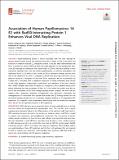Association of human papillomavirus 16 E2 with Rad50-interacting protein 1 enhances viral DNA replication
Abstract
Rad50-interacting protein 1 (Rint1) associates with the DNA damage response protein Rad50 during the transition from the S phase to the G2/M phase and functions in radiation-induced G2 checkpoint control. It has also been demonstrated that Rint1 is essential in vesicle trafficking from the Golgi apparatus to the endoplasmic reticulum (ER) through an interaction with Zeste-White 10 (ZW10). We have isolated a novel interaction between Rint1 and the human papillomavirus 16 (HPV16) transcription and replication factor E2. E2 binds to Rint1 within its ZW10 interaction domain, and we show that in the absence of E2, Rint1 is localized to the ER and associates with ZW10. E2 expression results in a disruption of the Rint1-ZW10 interaction and an accumulation of nuclear Rint1, coincident with a significant reduction in vesicle movement from the ER to the Golgi apparatus. Interestingly, nuclear Rint1 and members of the Mre11/Rad50/Nbs1 (MRN) complex were found in distinct E2 nuclear foci, which peaked during mid-S phase, indicating that the recruitment of Rint1 to E2 foci within the nucleus may also result in the recruitment of this DNA damage-sensing protein complex. We show that exogenous Rint1 expression enhances E2-dependent virus replication. Conversely, the overexpression of a truncated Rint1 protein that retains the E2 binding domain but not the Rad50 binding domain acts as a dominant negative inhibitor of E2-dependent HPV replication. Put together, these experiments demonstrate that the interaction between Rint1 and E2 has an important function in HPV replication.
Citation
Campos-León , K , Wijendra , K , Siddiqa , A , Pentland , I , Feeney , K M , Knapman , A , Davies , R , Androphy , E J & Parish , J L 2017 , ' Association of human papillomavirus 16 E2 with Rad50-interacting protein 1 enhances viral DNA replication ' , Journal of Virology , vol. 91 , no. 5 , e02305-16 . https://doi.org/10.1128/JVI.02305-16
Publication
Journal of Virology
Status
Peer reviewed
ISSN
0022-538XType
Journal article
Description
This work was supported by a Royal Society university research fellowship awarded to J.L.P. (UF110010). K.C.-L. is supported by a Medical Research Council research grant awarded to J.L.P. (MR/N023498/1).Collections
Items in the St Andrews Research Repository are protected by copyright, with all rights reserved, unless otherwise indicated.

